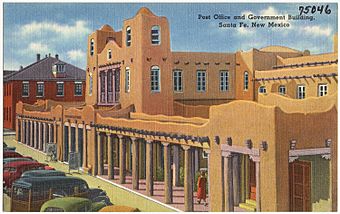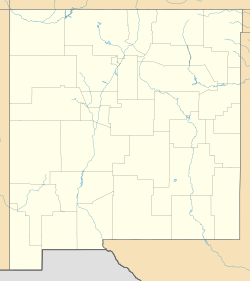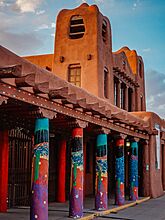Institute of American Indian Arts facts for kids
| Type | Public tribal land-grant college |
|---|---|
| Established | 1962 |
| Affiliation | AIHEC |
| President | Robert Martin |
| Location |
,
,
United States
35°35′13″N 106°00′36″W / 35.587°N 106.010°W |
| Colors | Silver & Turquoise |
| Mascot | Thunderbird |
| Website | |
|
Federal Building
|
|

20th Century postcard depicting the Federal Building
|
|
| Location | 108 Cathedral Place at Palace St., Santa Fe, New Mexico |
| Area | 1 acre (0.40 ha) |
| Built | 1920 |
| Architectural style | Pueblo |
| NRHP reference No. | 74001207 |
| Significant dates | |
| Added to NRHP | August 15, 1974 |
The Institute of American Indian Arts (IAIA) is a special college in Santa Fe, New Mexico, USA. It is a public college that focuses on Native American art. This college is also a tribal land-grant college. This means it gets support to help Native American students get a great education.
IAIA runs the Museum of Contemporary Native Arts (MoCNA). This museum is in the old Santa Fe Federal Building. This building is famous for its Pueblo Revival style and is listed as a historic place. The museum holds over 7,000 pieces of modern Native American art.
Contents
The Story of IAIA
The Institute of American Indian Arts started in 1962. It was co-founded by Lloyd Kiva New (a Cherokee artist) and Dr. George Boyce. They received money from the Bureau of Indian Affairs (BIA) to start the school. The idea for the school came from a need for better education for Native American students. It also came from the BIA's growing interest in higher education. The Rockefeller Foundation also helped with this project.
IAIA first opened on the Santa Fe Indian School campus in October 1962. From 1962 to 1979, it had a high school program. In 1975, it began offering college and advanced art classes. In 1986, IAIA became a special nonprofit organization. This change made it separate from the BIA, similar to how the Smithsonian Institution works.
In 1994, IAIA became a land-grant college. This was a big step, helping it get more support. The school became officially recognized for its four-year degrees in 2001. In 2013, it added a two-year MFA program for creative writing.
Today, IAIA has a large campus about 12 miles (19 km) south of downtown Santa Fe. It also runs the Museum of Contemporary Native Art in Santa Fe Plaza. Plus, it has a Center for Lifelong Education for continued learning.
IAIA Museum of Contemporary Native Arts
In 1991, the college opened its own museum. It is now called the IAIA Museum of Contemporary Native Arts (MoCNA). This museum is in downtown Santa Fe. It focuses on modern art made by different Native American tribes. The MoCNA is located in the historic Santa Fe Federal Building. This building is famous for its Pueblo Revival style. The museum also has the Allan Houser Sculpture Garden, which shows amazing sculptures.
-
IAIA MoCNA columns with a sculpture by Bob Haozous
Working Together: IAIA Partnerships
IAIA is part of the American Indian Higher Education Consortium. This group includes many colleges that help strengthen tribal nations. They work to improve the lives of American Indians and Alaska Natives. IAIA often helps Native American communities that are far away from other schools. It gives them a chance to get a college education.
In the early 1970s, a group called the E-Yah-Pah-Hah Chanters toured the country. These were students from IAIA, led by faculty member Ed Wapp, Jr. They performed traditional and modern American Indian music. Their songs came from many different Native American regions.
Student Life at IAIA
Students at IAIA come from many different backgrounds. Most students are American Indian or Alaska Native. The college helps students from all walks of life get an education.
| Race and ethnicity | Total | ||
|---|---|---|---|
| American Indian/Alaska Native | 66% |
|
|
| Two or more races | 14% |
|
|
| Hispanic | 12% |
|
|
| White | 7% |
|
|
| Unknown | 1% |
|
|
| Economic diversity | |||
| Low-income | 55% |
|
|
| Affluent | 45% |
|
|
Amazing Teachers at IAIA
Many talented artists and scholars have taught at IAIA. Here are some of them:
- Imogene Goodshot Arquero, a beadwork artist
- Louis W. Ballard, a composer
- Gregory Cajete, an ethnobiologist and author
- Karita Coffey, a ceramist
- Jon Davis, a poet
- Lois Ellen Frank, a food historian
- Allan Houser, a famous sculptor
- Charles Loloma, a jeweler
- Otellie Loloma, a potter, sculptor, and painter
- Linda Lomahaftewa, a printmaker
- Larry McNeil, a photographer
- N. Scott Momaday, a writer
- Josephine Myers-Wapp, a textile artist
- Wendy Ponca, a fashion designer
- Fritz Scholder, a painter
- Arthur Sze, a poet
- James Thomas Stevens, a poet and writer
- Azalea Thorpe, known for fiber arts
- Charlene Teters, a painter and installation artist
- Gerald Vizenor, a writer
- Will Wilson, a photographer
- Elizabeth Woody, an artist and author
- Melanie Yazzie, a printmaker
- William S. Yellow Robe, Jr., a writer
Famous Students from IAIA
Many students who attended IAIA have become well-known artists and writers. Here are some of them:
- Marcus Amerman, a beadwork artist
- Ralph Aragon, a painter and sculptor
- Katie Doane Tulugaq Avery, a filmmaker
- Alexandra Backford, a painter
- Esther Belin, a multimedia artist and writer
- Earl Biss, a painter
- Sherwin Bitsui, a poet
- Diane Burns, a poet
- Jackie Larson Bread, a beadwork artist
- T.C. Cannon, a painter and printmaker
- Sherman Chaddlesone, a painter
- Eddie Chuculate, an author and journalist
- Kelly Church, a basket maker
- Karita Coffey, a ceramic artist
- Bunky Echo-Hawk, a painter
- Anita Fields, a ceramicist
- Bill Glass Jr., a ceramic artist and sculptor
- Gina Gray, a printmaker and painter
- Benjamin Harjo Jr., a painter and printmaker
- Joy Harjo, a poet and jazz musician
- Allison Hedge Coke, an author
- Kevin Locke, a hoop dancer
- Gerald McMaster, an author, artist, and curator
- Melissa Melero-Moose, a mixed-media artist
- America Meredith, a painter, printmaker, and curator
- Patricia Michaels, a fashion designer
- Dan Namingha, a painter and sculptor
- Jody Naranjo, a potter
- Jamie Okuma, a beadwork artist and fashion designer
- Tommy Orange, a best-selling novelist
- Mary Gay Osceola, a painter and printmaker
- Chris Pappan, a ledger artist
- Kevin Red Star, a painter
- Layli Long Soldier, a poet, writer, and artist
- James Thomas Stevens, a poet
- Roxanne Swentzell, a ceramic artist and sculptor
- Charlene Teters, a painter and installation artist
- Randy'L He-dow Teton, a model for the Sacajawea Gold Dollar coin
- Hulleah Tsinhnahjinnie, a photographer and writer
- Marty Two Bulls Sr., an artist
- Marie Watt, a textile artist
- Terese Marie Mailhot, a writer
- Jolene Yazzie, a graphic designer
- Debra Yepa-Pappan, a digital multimedia artist
- Alfred Young Man, a painter, author, and professor
- Vernon Bigman, an abstract painter
Important Leaders and Staff
These people helped lead and manage IAIA:
- Margaret L. Archuleta, an art historian and museum director
- Lloyd Kiva New, a co-founder and president
- Joseph Sanchez, a curator and artist
- Duane Slick, a painter who taught at IAIA
See also
- C.N. Gorman Museum in Davis, California: This museum is similar to the IAIA Museum. It also focuses on modern art from different Native American tribes.







